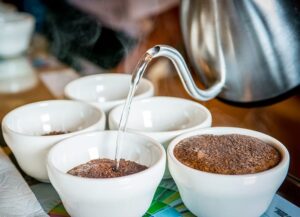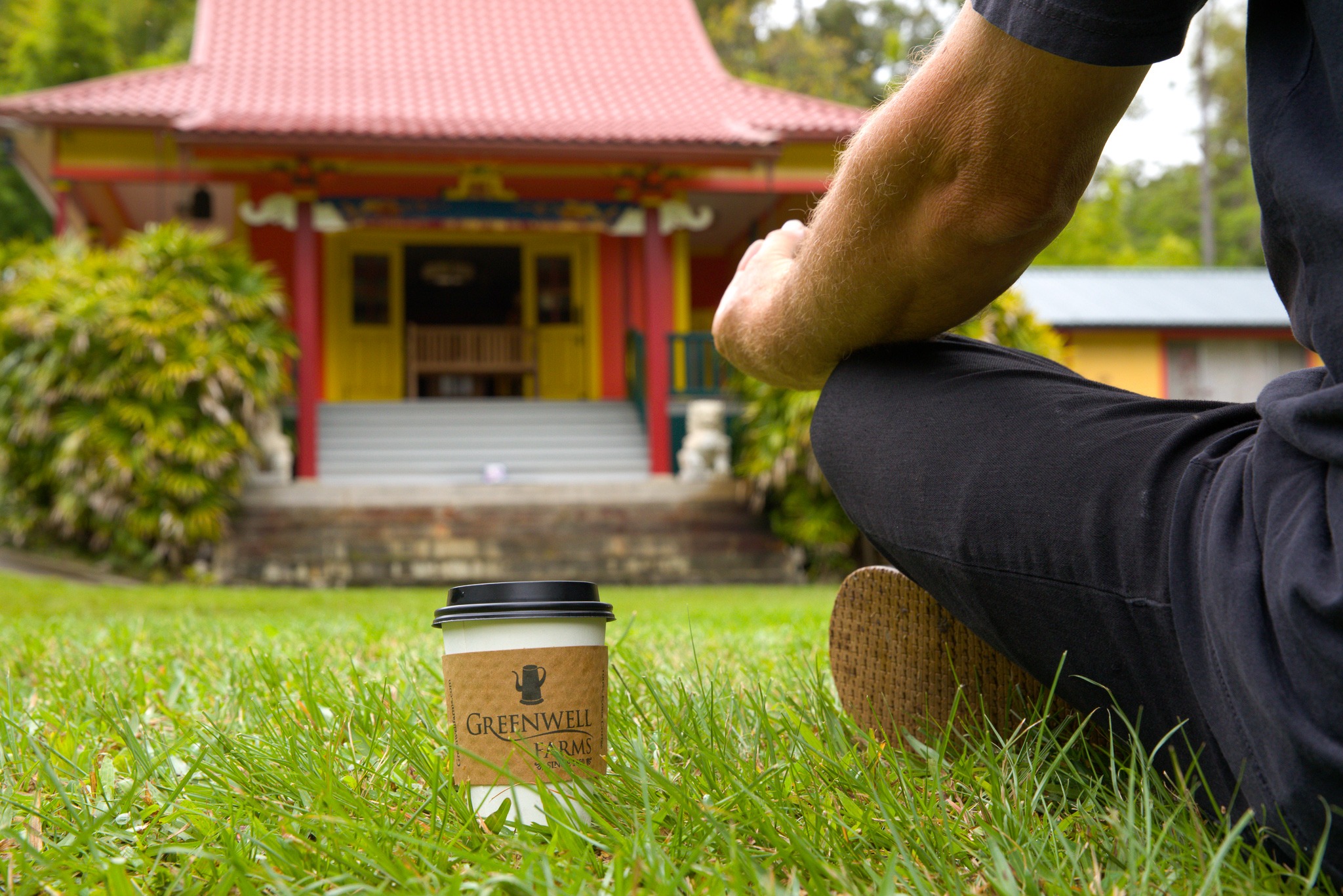Getting The Most From Your 100% Kona Coffee
You’ve chosen some of the best coffee in the world. How do you reveal its character and complexity?

First, what separates Kona Coffee from others?
If you are laying down Kona Coffee Money, you will need some information to get the most from your coffee. Believe it or not, while 100% Kona Coffee tastes amazing, it is not actually famous for its exact flavor profile. Imagine a Sour Cream and Onion potato chip for a second. That particular combination of salty and fatty with a hint of bitter/sour comprises the flavor of the chip and SC&O chips are indeed famous for the way that they taste. When it comes to Kona Coffee (or coffee) however, flavor profiles vary widely based on origin, roast level, processing method, harvesting practices, and even storage and shipping. You could visit five Kona Coffee farms side-by-side and each of their coffees would have differences noticeable to anyone who took the time to understand. Even at the same farm you could try 3 or 4 of their coffees and have one that tasted better to you than the others. Yet, if you were to examine those coffees more deeply, you might discover the characteristics that define them as being from Kona.
- Location, Location, Location (The Terroir): The French use the word “Terroir” to define a geographic region with a multitude of factors (rainfall, soil, climate, etc…) that impart a particular set of characteristics to wine grapes, or in this case, to the coffee fruit. Kona Coffee grows only in a very limited section of the Big Island of Hawaii known as the Kona Coffee Belt. It is roughly 35 miles long, 1-2 miles wide with elevation ranging from 500 to 3,200 feet. If your coffee grows in this zone you can sell it as Kona Coffee, and if it doesn’t, you can’t. The meaning is that if you took a random tree out of the Kona Coffee Belt and put it anywhere else in the world, it wouldn’t taste the same. The Kona Coffee belt, with its slightly acidic, mineral-rich, well-drained volcanic soil, its 60+ inches of rain in spring and summer, its warm days and mild nights, it’s well defined sunny mornings and cloudy afternoons, create a coffee like no other. Add to that hand-picking at the peak of ripeness, sun drying of the coffee, and meticulous care during every step of the process and you have a coffee with low bitterness, bright mouth acidity, and an exceptional finish. Let’s look at these a bit more closely.
- The Nose Knows: The first point you will notice in Kona Coffee is the aromatics, first from the roasted beans themselves and then as they extract into your cup. While coffee smells range from floral, spicy, fruity, winey, sweet, chocolaty, earthy, nutty and tobaccoey, Kona Coffees are considered floral and light up that same portion of your brain as when you smell flowers. Just imagine how sweet and aromatic the flowers of Hawaii are and you will get an idea of the subtle difference. Floral and herbaceous with hints of sweetness and nuttiness, Kona Coffee is one of the best smelling coffees in the world. As the roast changes you will pick up different notes in the aroma but Kona Coffee (roasted beans in the bag) should always smell amazing.
- Like a Gentle Hawaiian Breeze: If you’ve ever felt the kiss of soft trade winds on your cheeks then you may understand another element of Kona Coffee’s uniqueness. As the trees grow in slightly acidic, mineral-rich volcanic soil with ample rain, mild temperature swings, and afternoon clouds, the fruit of the Arabica trees in Kona have a natural mildness, a softness of cup, that means your Kona Coffee is always going to be a flavorful but delicate cup of coffee. In fact, people who are used to drinking very bold types of coffee often comment that Kona Coffee drinks closer to a tea. Tea? Hmm. Anyway, Kona Coffee is exceptionally mild and smooth, has almost no bitterness, and its complexity reveals in quiet tones rather than loud ones. Drinking Kona Coffee regularly for about 2 weeks, you will become familiar with its very understated yet elegant nature.
- A Happy Ending: Once while doing a Champagne tasting, our guide pointed out that the more expensive Champagnes were prized for how they finished – how the bubbles would build and then dissipate before they reached your throat. Our guide said the bubbles should be firm, but soft, and melt away revealing the champagne’s flavor. In this same way, 100% Kona coffees are prized for their smooth and silky finish. Many coffees as they move to the back of your palette will “drop” on to the top of your throat, but Kona Coffees move toward the back of the mouth and then fade gently leaving a crisp and delightful experience on your tongue. It is often described as a silky finish with an exquisite after taste.
Setting You Inner Mad Scientist Free
Now that you know a little more about what qualities you are looking for in your 100% Kona Coffee, let’s dig in and see if we can coax the best from your coffee. When it comes to the extraction process (brewing the coffee), there are many factors that you will have to take into consideration. Those are water quality and temperature, the coarseness of the grind and grinding method, filtering system (brewing method), amount of grounds per liquid and freshness of the coffee.
Let’s look at each of these a little more closely. Keep in mind that at the end of the day, it is your coffee. You are drinking it and it will be your nose and mouth that determine if you are happy with the way it is revealing.
- Human Body 60%, Earth 71%, Coffee 99% (Water): The temperature of your water is very important. It should be between 195 F (91 C) and 205 F (96 C). Closer to 205 F (96 C) is better. Boiling water (212 F – 100 C) should never be used as it will burn the coffee and you will lose much of its character. Water that is less than 195 F (91 C) will not extract properly and leave a lot of taste in the bean and not your cup.
Considering that 99% of your coffee is the water itself, water quality is paramount. Bottled spring water is going to give you the best taste (like a Crystal Geyser), but even those are not all created equal. Never use sink water (unless you have an incredible filtering system) and never use distilled water (unless you are adding minerals). Taste your water first and see if it is indeed flavorless, odorless, and with no distinguishing characteristics.
The SCA states that “for a superior quality coffee extraction, your water should be clean, fresh, odor-free, clear in color, and should have a mineral content of around 150 parts per million (ppm), while the best water pH for coffee is 7.0 (neutral).” If your water is perfect, your coffee will have a much better chance at perfection. Bad water equals bad coffee. - The Daily Grind: As a general rule, the longer the water is in contact with the coffee, the coarser the grind should be. Technically speaking, are you percolating or macerating the coffee? Percolating means the water flows through the coffee and macerating is when the coffee is steeped in the water. Is the coffee taking a shower or a bath? In the case of a quick shower, a very fine grind will allow the flavor to extract more easily (espresso maker) and in the case of a long bath, a course grind will hold back some of the more bitter elements (cold brew). Here is the age-old quest for the perfect balance between grind size and extraction time. Over-extracted is just as bad as under-extracted and here is where your mad scientist needs to play. Experiment with a few different sizes and methods, adjust timing and take notes so you can refer back to your previous trials.
Grinders themselves come in a multitude of styles but these days you may hear about the burr grinder versus the blade grinders. The simple concept is that burr grinders give you more precise sizes so that the overall size of each individual coffee granule when ground is about the same and thus, they all extract at the same rate as opposed to blade grinders that chop up the coffee in many different sizes (when seen under the microscope) and extract differently. I’ve seen burr grinders for upwards of $2,000 but many models hover around $150. Try an inexpensive, but authentic one, first and see if you like the result. - Just Brew It: French press? Paper filter? Hand pour? Ionized gold filter? Burlap sock? Aero press? Moka pot? Percolator? Espresso maker? Vacuum pot? K-Cup? Are you kidding me? Although brewing methods come in many forms and everyone has their favorite, what has changed in my generation is that we are not limited to one style. My mom used her Mr. Coffee every morning for 35 years. That was coffee….no questions asked. These days, much in the way we like to try beers from all over the world rather than just Bud, using the various brew methods on different occasions is how we drink coffee. Having a leisurely morning with your partner? French press. Just got in a new batch of exotic coffee? Hand pour or aero press. Need a pick-me-up, but want to sleep in 3-4 hours? Espresso shot. Going camping? Percolator. This is the age of the informed decision where options are viewed on a case-by-case basis. As you can and at your own pace, become familiar with the different ways of making your coffee and note the occasions where the different methods would be appropriate.
- Grounds : Liquid: The industry standard and what you will see on most coffee charts is 2 Tablespoons of coffee (about 10 grams) per 6 oz cup. Some are more imprecise where they say a heaping 2-Tablespoon coffee scoop per 8 oz cup. The long and short of it is that not all coffees are created equal and not all coffee drinkers like their coffee the same way. Start with your 2 TBS per 6 oz cup and then day-by-day, adjust a bit higher or lower. If you stumble upon a ratio you really like, try it again 3-5 times and see if your results are consistent. 16:1 ratio of coffee grounds to water is industry baseline. Some coffee scoops are more precise than others and so pros usually weigh their coffee, but it is really a matter of how much time you have to make your coffee. The weighing gives you a much better way to know exactly how much coffee you are using. Additionally, keep in mind that the actual “strength” of the coffee as described by industry professionals can be influenced at this step. Adding more grounds per liquid can greatly change the strength of the coffee in terms of caffeine, flavor, and overall balance.
- Keep it Real: Up until a few years ago, storing coffee in the freezer was a pretty common way to keep coffee fresh, however, deeper research into this issue has definitively shown it not to be the case. The enemies of freshness are air, moisture, heat, and light. Storing coffee in the freezer (or refrigerator) can change the quality of your beans and dull their taste. Not only are freezer and fridge humid environments, but the temperature changes daily, especially when you are taking the coffee out and putting it back in every morning. This creates lots of moisture problems which actually has been shown to break down the cell structure of the beans and can leave your coffee flavorless. The only time we recommend you keep coffee in the freezer is if you bought it in bulk and want to store it. Once you take it out…keep it out.
You must also keep the air off of your coffee. Storing it in the bag in an airtight container is the way to go. Several specialty coffee storage products with air plungers, one-way valves, and sealed lids are available to purchase. When using one of these simply put your coffee in the pantry or the cupboard. Keeping your coffee dark, cool, and dry without air exposure is the recipe for freshness.
Buying your coffee fresh roasted in quantities that you can consume within 1-2 months helps resolve many freshness issues as well.
and in the end…the love you take is equal to the love you make
The information provided here is intended to help you get the most from your 100% Kona Coffee. The keyword being “help.” Learning to make coffee well is an art that requires dedication and diligence that pays off in exquisite flavors and knowing that you are experiencing your gourmet coffee at the highest level. There are however 2 more things I’d like you to keep in mind.
There is no right or wrong way to enjoy your coffee in terms of your enjoyment of it. If you like to fill half of your coffee mug with Bailey’s, don’t let anyone tell you differently. Coffee is a food product that you have the right to enjoy any way that pleases you.
The ability to make coffee and learning all of the intricacies of the process is not for everyone. It should be an enjoyable journey of discovery with peaks and valleys, summits, and plateaus. Your current cup of coffee is a temporary destination in a longer and larger adventure. Each cup you enjoy can be an experience that will add to and enhance your overall awareness of the flavors and aromas of life. Happy Drinking.

Matt Carter is a retired teacher (1989-2018), part-time musician, farmer, and currently manages Greenwell Farm’s Tour and Retail Store Operations.






